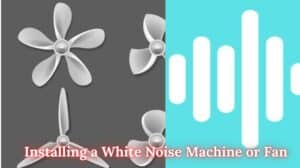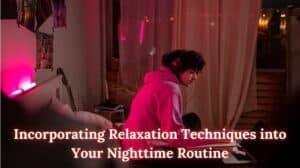Do you ever find yourself struggling to get a good night’s rest due to the sound of traffic outside your bedroom window? If so, you’re not alone. Fortunately, there are some simple steps you can take to block out traffic noise in your bedroom and create a Peaceful Bedroom Sanctuary for sleep. From soundproofing solutions to strategically placed white noise, this blog post will provide you with the tips you need to say goodbye to traffic noise and hello to a blissful night’s rest.
Identifying the Source of Traffic Noise

One of the first steps in creating a peaceful bedroom sanctuary is identifying the source of the traffic noise that is disturbing your sleep. By pinpointing where the noise is coming from, you can then take the necessary steps to effectively block it out.
To start, take some time to really listen and identify the specific sounds of the traffic. Is it the loud rumble of cars passing by? The blaring horns? Or perhaps the screeching of brakes? Understanding the types of sounds you are dealing with can help you determine the best course of action.
Once you have a good idea of the sounds, it’s time to locate the source. Stand in different areas of your bedroom and try to determine where the noise is loudest. Is it coming from a specific window? Is it louder near the walls? By moving around and actively listening, you can begin to narrow down the problem areas.
Another helpful tip is to take note of the time when the traffic noise is at its peak. Is it during rush hour in the morning and evening? Or does it vary throughout the day? Knowing the specific times when the noise is most bothersome can also provide insight into potential solutions.
If you’re having trouble pinpointing the exact source of the traffic noise, consider speaking with your neighbors. They may have experienced similar issues and can provide valuable information on where the noise is coming from and potential remedies they have tried.
Once you have identified the source or sources of the traffic noise, you can move on to implementing the necessary steps to block it out and create a peaceful sanctuary in your bedroom. So, let’s dive into the next section and analyze the structure of your Peaceful Bedroom to see what modifications can be made to reduce the noise even further.
Analyzing the Structure of Your Bedroom

Now that you’ve identified the source of the traffic noise, it’s time to take a closer look at the structure of your bedroom and see what modifications can be made to further reduce the noise. This step is crucial in creating a Peaceful Bedroom sanctuary where you can truly relax and get a restful night’s sleep.
Start by examining the windows in your bedroom. Windows are often one of the main entry points for outside noise. Are they single-pane or double-pane? Single-pane windows provide little to no soundproofing, so consider upgrading to double-pane windows if possible. These windows are specifically designed to reduce noise transmission, providing a much quieter indoor environment. If replacing your windows is not an option, there are other solutions you can try.
Next, inspect the walls of your bedroom. Are they thin and poorly insulated? Thin walls allow noise to easily penetrate into your bedroom, disrupting your sleep. If this is the case, consider adding extra insulation to your walls. This can be done by installing acoustic panels or insulation material. These materials work to absorb and dampen sound waves, significantly reducing the amount of noise that enters your room.
Another area to analyze is the flooring in your bedroom. Hardwood or laminate floors can amplify sound, allowing traffic noise to bounce around and disrupt your sleep. Consider adding a thick rug or carpet to help absorb sound and create a quieter environment. Additionally, using heavy curtains or blinds on your windows can also help to block out noise.
As you analyze the structure of your bedroom, it’s important to keep in mind that no single solution will completely block out traffic noise. However, by combining multiple strategies, you can significantly reduce the amount of noise that enters your sleeping space.
In the next section, we will explore some effective techniques for soundproofing your windows and walls. By implementing these solutions, you’ll be one step closer to creating a peaceful bedroom sanctuary and bidding farewell to disruptive traffic noise. Stay tuned!
Soundproofing the Windows and Walls

Block out the noise, and create a peaceful sanctuary. In the previous section, we explored how to identify the source of the traffic noise in your bedroom and analyze the structure of your space. Now, let’s dive into the next step: soundproofing the windows and walls.
Windows are often the main culprits when it comes to noise entering your bedroom. Single-pane windows offer little to no soundproofing, so if you have them, it might be time to consider an upgrade. Double-pane windows are specifically designed to reduce noise transmission,
providing you with a much quieter indoor environment. They have an air gap between the two panes of glass, which helps to block out sound waves. Investing in double-pane windows can make a significant difference in reducing traffic noise in your bedroom.
If replacing your windows is not an option, there are still other solutions to explore. One effective option is to install soundproof curtains or blinds. These specially designed curtains are made with thick, dense materials that help to absorb and block out sound. They are a great addition to any window, providing both noise reduction and privacy.
Moving on to the walls, thin and poorly insulated walls allow noise to easily penetrate into your bedroom. Adding extra insulation can help to dampen the noise and create a quieter environment. One option is to install acoustic panels or insulation material.
Another consideration for soundproofing your walls is the use of soundproof wallpaper. This specialized wallpaper contains an extra layer of sound-dampening material, which helps to reduce noise transmission. It can be applied to the walls just like regular wallpaper and can make a noticeable difference in blocking out traffic noise and Creating a Peaceful Bedroom Sanctuary.
Adding Acoustic Materials

When it comes to blocking out traffic noise in your bedroom, adding acoustic materials can be a game-changer. These materials are specifically designed to absorb and dampen sound waves, helping to create a peaceful and quiet sanctuary for sleep.
One effective option for adding acoustic materials is to install acoustic panels on the walls of your bedroom. These panels are made of dense and sound-absorbing materials, such as foam or fiberglass, and can significantly reduce noise transmission. They are available in various sizes and shapes, making it easy to customize them to fit your space. By strategically placing these panels on your walls, you can effectively block out traffic noise and create a more tranquil environment.
Another option for adding acoustic materials is to use soundproof wallpaper. This specialized wallpaper contains an extra layer of sound-dampening material, which helps to reduce noise transmission. It can be applied to the walls just like regular wallpaper and can make a noticeable difference in blocking out traffic noise.
If you have hardwood or laminate flooring in your bedroom, adding acoustic underlayment can help to absorb sound and reduce noise. This underlayment is typically made of materials like cork or rubber, which help to create a barrier between your floor and the traffic noise outside. By installing acoustic underlayment under your carpet or rugs, you can further minimize the impact of traffic noise on your sleep.
In addition to acoustic panels, soundproof wallpaper, and acoustic underlayment, there are other smaller acoustic materials you can add to your bedroom. For example, using thick curtains or blinds on your windows can help to block out noise. Additionally, adding acoustic foam to the inside of your bedroom door can help to reduce noise transmission from outside.
By incorporating these acoustic materials into your bedroom, you can effectively block out traffic noise and create a more peaceful environment for sleep. Remember, no single solution will completely eliminate all traffic noise, but by combining multiple strategies and materials, you can significantly reduce its impact. Say goodbye to disruptive traffic noise and hello to a blissful night’s rest in your Peaceful Bedroom sanctuary.
Installing a White Noise Machine or Fan

Now that you’ve taken steps to soundproof your bedroom and create a Peaceful Bedroom sanctuary., it’s time to consider adding a white noise machine or fan to your sleep routine. These devices can be incredibly effective in blocking out traffic noise and creating a calming atmosphere for sleep.
White noise machines generate a uniform and calming sound that effectively conceals ambient noise. By generating a constant stream of sound, white noise machines effectively “fill in the gaps” of noise, making it less noticeable to your ears. This can help to drown out the sounds of passing cars or honking horns, allowing you to drift off to sleep more easily.
When choosing a white noise machine, look for one that offers a variety of sound options. Some machines provide different white noise variations, such as rain sounds, ocean waves, or even gentle fan noise. Experiment with different sounds to find the one that works best for you and effectively blocks traffic noise.
Alternatively, you can also consider using a fan as a source of white noise. Fans produce a constant hum that can help to drown out external sounds. Not only does a fan provide a soothing sound, but it can also circulate the air in your room, keeping it cool and comfortable for sleep.
To install a white noise machine or fan in your bedroom, place it in a location that provides the best coverage of the room. Ideally, it should be placed between you and the source of traffic noise. Experiment with different positions to find the optimal placement that provides the most effective noise masking.
Remember, the goal of a white noise machine or fan is to create a consistent background sound that blocks out traffic noise, so make sure the volume is set at a level that is soothing and comfortable for you. It should be loud enough to mask the traffic noise but not so loud that it becomes distracting or prevents you from falling asleep.
By installing a white noise machine or fan in your bedroom, you can effectively block out traffic noise and create a more Peaceful Bedroom sleep environment. Combined with the other strategies discussed in this blog post, you’ll be well on your way to saying goodbye to disruptive traffic noise and hello to a restful night’s sleep in your bedroom sanctuary.
Choosing the Right Bed and Bedding

Choosing the right bed and bedding is essential for creating a peaceful bedroom sanctuary that effectively blocks out traffic noise. When it comes to blocking sound, you want to prioritize materials and designs that absorb and dampen noise rather than transmit it. Here are some tips to help you choose the right bed and bedding for a quieter sleep environment.
Firstly, consider investing in a solid bed frame. Metal bed frames can amplify sound vibrations, so opting for a wooden or upholstered frame can help reduce noise transmission. Additionally, a sturdy frame can minimize creaking and other noises that can disrupt your sleep.
Next, focus on your mattress. Look for one that provides excellent motion isolation to minimize any movement-related noise. Memory foam mattresses are known for their ability to absorb vibrations, making them a great option for reducing noise disturbances. Additionally, choosing a mattress with a thicker comfort layer can help provide further sound insulation.
When it comes to bedding, opt for materials that absorb sound rather than reflect it. Avoid crisp or noisy fabrics such as stiff cotton or silk. Instead, consider using thicker, more substantial materials like flannel or microfiber. These materials not only help to dampen sound but also provide a cozy and comforting sleep environment.
Additionally, consider using a mattress topper to add an extra layer of noise absorption. Toppers made from memory foam or latex can help cushion your body and minimize the transmission of sound. Plus, they can add an extra level of comfort to your bed.
Finally, don’t forget about your pillows. Opt for pillows made from materials that absorb sound, such as memory foam or a down alternative. Avoid pillows that crinkle or rustle, as they can contribute to noise disturbances.
By choosing the right bed and bedding materials, you can create a sleep environment that effectively blocks out traffic noise and promotes a peaceful night’s rest. Remember to prioritize materials that absorb sound rather than transmit it, and opt for sturdy and solid construction to minimize noise disruptions. With the right bed and bedding, you’ll be one step closer to saying goodbye to traffic noise and hello to a blissful night’s sleep.
Incorporating Relaxation Techniques into Your Nighttime Routine

Creating a peaceful bedroom sanctuary isn’t just about blocking out traffic noise; it’s also about incorporating relaxation techniques into your nighttime routine. By dedicating time to unwind and de-stress before bed, you can set the stage for a restful night’s sleep. Here are some effective relaxation techniques to help you block out traffic noise and promote a tranquil sleep environment.
One powerful technique is to practice deep breathing exercises. Taking slow, deep breaths can activate your body’s relaxation response, reducing stress and calming your mind. Before getting into bed, find a quiet and comfortable spot in your Peaceful Bedroom. Please close your eyes and proceed to inhale deeply through your nasal passage, followed by a slow exhalation through your oral cavity. Focus on the sensation of your breath, allowing it to anchor your attention and draw your mind away from any external noise. Repeat this breathing exercise for several minutes to induce a state of relaxation.
Another effective relaxation technique is progressive muscle relaxation. This involves systematically tensing and relaxing each muscle group in your body. Commence by assuming a comfortable posture on your bed. Beginning with your toes, slowly tense the muscles in that area for a few seconds, and then release the tension as you exhale. Move on to your calves, thighs, abdomen, and so on, working your way up your body. By consciously releasing tension from each muscle group, you can promote a sense of physical and mental relaxation, which can help block out any lingering traffic noise.
In addition to deep breathing exercises and progressive muscle relaxation, you may also find it helpful to incorporate mindfulness meditation into your nighttime routine. Mindfulness involves being fully present and aware of your thoughts, feelings, and bodily sensations. By practicing mindfulness, you can develop a greater sense of inner calm and reduce the impact of external noise on your sleep. Before getting into bed, find a quiet corner of your bedroom, close your eyes, and focus your attention on your breath. As thoughts arise, gently acknowledge them and then let them go, bringing your attention back to your breath. Engaging in this practice can help create a sense of mental stillness and block out any distractions, including traffic noise and Peaceful Bedroom.
By incorporating these relaxation techniques into your nighttime routine, you can enhance your ability to block out traffic noise and create a peaceful sanctuary for sleep. Remember, the goal is not to completely eliminate all noise but rather to train your mind to become less reactive to it.
2 thoughts on “Goodbye Traffic, Hello Sleep: How to Create a Peaceful Bedroom Sanctuary”